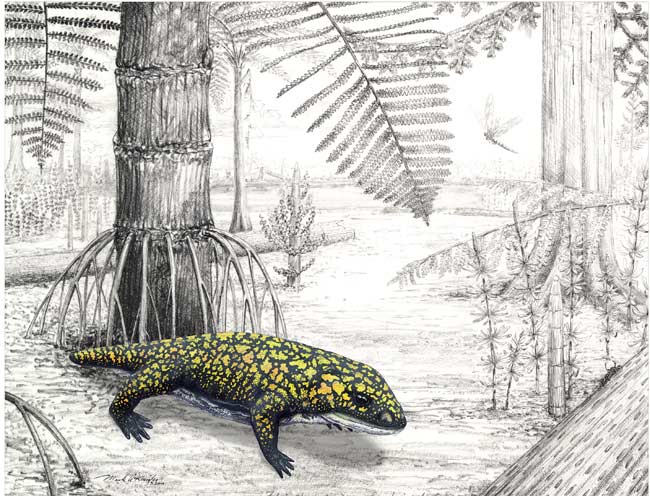Ancient Amphibian Skull Discovered at Airport

A meat-eating amphibian that lived 300 million years ago may represent one of the earliest examples of land-based vertebrate life, scientists announced today.
Researchers discovered the fossilized head of the ancient creature in 2004, near the Pittsburgh International Airport in western Pennsylvania. The ancient amphibian has been dubbed Fedexia striegeli after FedEx, which owns the land on which the fossil was found, and for Adam Striegel, who discovered the specimen while on a field trip as an undergrad at the University of Pittsburgh.
Scientists think the species lived during an important turning point for Earth's vertebrate life (animals with backbones), which had mostly been water-based until that period. Our planet's climate was changing around that time, becoming warmer and drier as it began to come out of an ice age.
"This reduced the number of environments for highly-aquatic amphibians to live in, and forced the amphibians to become more terrestrial," said study co-author David Brezinski, a paleontologist at the Carnegie Museum of Natural History in Pittsburgh.
The creature lived during the Late Pennsylvanian Period, or about 100 million years before mammals first appeared, and about 70 million years before dinosaurs began to walk the Earth. Because of the shifting of Earth's plates, during this period Pennsylvania was actually located near the equator, with a climate close to what we find in the Amazon basin today.
"At that time, we had a number of widely distributed rare instances of other highly terrestrial animals that make their appearance in the fossil record," said co-researcher David S. Berman, also of the Carnegie Museum.
But the fact that animals with features that had evolved for living on land were showing up at this time means they had probably begun to make the shift even earlier, he said.
Sign up for the Live Science daily newsletter now
Get the world’s most fascinating discoveries delivered straight to your inbox.
"They're already so highly advanced for a terrestrial existence, they must have been around for a while," Berman told LiveScience.
The researchers think Fedexia striegeli lived primarily on land because of a few features found on its well-preserved skull, which was about five inches long (11.5 centimeters). First, its nasal opening was divided into two portions, and scientist think the back portion held a gland that might have increased its sense of smell, or rid the body of excess salt. Both functions would have been helpful for terrestrial creatures.
The amphibian also lacked a set of grooves in its skull called a lateral line – a feature left over in many species from their fish ancestors. The lateral line helped aquatic animals to sense vibrations in water, which aided in hunting for food or prey, but served no purpose on land.
And finally, Fedexia striegeli's bones were highly ossified, which means they were thick and well-developed – another sign that a creature was walking around bearing its weight on land.
The researchers described their findings in the March 15 issue of the Annals of Carnegie Museum.
- Top 10 Useless Limbs (and Other Vestigial Organs)
- Images: New Amphibian Tree of Life
- Video: How Salamanders Walk and Swim










